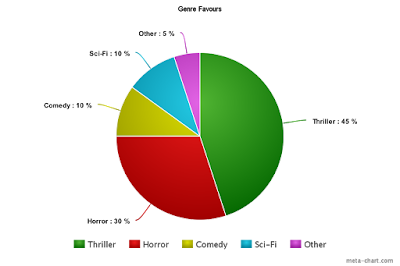Tuesday, 10 May 2016
Wednesday, 23 March 2016
Evaluation Question 7
Welcome back! Today, I will be answering Evaluation Question #7!
Evaluation Question #7: Looking at your Preliminary Task what do you feel that you have learnt in the progression from it to the full product?
So I will be showing you technical aspects to the final product compared to the preliminary task. I have created two keyframes in which display problems that we encountered in the preliminary task and how those technical aspects have changed in the final product.
KEYFRAME ANALYSIS
Prelim #1: This is a match on action in which I placed into the keyframe because of a slight development. The preliminary Task match on actions were completely fine however we developed this skill by being more accurate with our match on actions in the full product.
Prelim #2 & Somnium #1: These two clips show development of the 180 degree rule. In which we broke in the preliminary task which you can see in Prelim #2. Somnium #1 shows how we have developed our use of the 180 degree rule by which we didn't break in Somnium. Furthermore, we can also suggest that our development in shot / reverse shots have developed by with in Prelim #2 we changed angle to the person who is speaking at the time and reversed each time for the conversation. Somnium #1 developed this because we added variety to the shot / reverse shot by showing the other persons face when one person was talking. This was to add variety to the shot rather than it being a game of tennis.
Prelim #3 Shows our establishing shot in the preliminary task. We have developed our establishing shot over time in our full product to have a tilt to which we set the location of the film. Compared to Prelim #3, It adds a more diverse entry to the location rather than a stationary establishing shot in which we used for Prelim #3.
Lastly, Prelim #4 shows a continuity error in the preliminary task. This was added to the keyframe because there was no continuity errors within our full product. This suggests that we have improved our awareness of continuity errors both in filming and editing. Furthermore, we can suggest that our improvement of awareness of continuity errors has improved the full product massively compared to the audience satisfaction, meaning that if continuity errors were present within the film then the audience has a chance to see them therefore comments about said errors might have came up in the audience feedback. This shows that our improvement in this technical aspect of the film ultimately has had an effect on the audience.
COMPARING THE PRELIMINARY TASK & PLANNING TO SOMNIUM'S RESEARCH
So in this section I will be talking about all the planning aspects of Somnium in which was not used in the preliminary task and how that effected the films outcome:
Evaluation Question #7: Looking at your Preliminary Task what do you feel that you have learnt in the progression from it to the full product?
So I will be showing you technical aspects to the final product compared to the preliminary task. I have created two keyframes in which display problems that we encountered in the preliminary task and how those technical aspects have changed in the final product.
KEYFRAME ANALYSIS
Prelim #1: This is a match on action in which I placed into the keyframe because of a slight development. The preliminary Task match on actions were completely fine however we developed this skill by being more accurate with our match on actions in the full product.
Prelim #2 & Somnium #1: These two clips show development of the 180 degree rule. In which we broke in the preliminary task which you can see in Prelim #2. Somnium #1 shows how we have developed our use of the 180 degree rule by which we didn't break in Somnium. Furthermore, we can also suggest that our development in shot / reverse shots have developed by with in Prelim #2 we changed angle to the person who is speaking at the time and reversed each time for the conversation. Somnium #1 developed this because we added variety to the shot / reverse shot by showing the other persons face when one person was talking. This was to add variety to the shot rather than it being a game of tennis.
Prelim #3 Shows our establishing shot in the preliminary task. We have developed our establishing shot over time in our full product to have a tilt to which we set the location of the film. Compared to Prelim #3, It adds a more diverse entry to the location rather than a stationary establishing shot in which we used for Prelim #3.
Lastly, Prelim #4 shows a continuity error in the preliminary task. This was added to the keyframe because there was no continuity errors within our full product. This suggests that we have improved our awareness of continuity errors both in filming and editing. Furthermore, we can suggest that our improvement of awareness of continuity errors has improved the full product massively compared to the audience satisfaction, meaning that if continuity errors were present within the film then the audience has a chance to see them therefore comments about said errors might have came up in the audience feedback. This shows that our improvement in this technical aspect of the film ultimately has had an effect on the audience.
COMPARING THE PRELIMINARY TASK & PLANNING TO SOMNIUM'S RESEARCH
So in this section I will be talking about all the planning aspects of Somnium in which was not used in the preliminary task and how that effected the films outcome:
- Film Treatment: The film treatment gave us a storyline of the film in which enabled us to visualise the story as a film before conducting more technical research just before filming the product.
- Scripts: The script was baron as well as the preliminary task however, using CeltX, we was able to create a more industry standard script in which helped our planning compared to the preliminary task in which we did not make any script.
- Storyboard: Storyboard's helped us plan exactly how the shots were going to be taken in terms of length, angle and distance. Furthermore, It also allowed us to visualise transitions which were not thought of until the point of creating a storyboard. Again, no storyboard was created during the preliminary task so there was no visualisation as to what the task was going to look like before hand.
- Animatic: An animatic allowed us to utilise and visualise transitions and soundtrack possibilities for the first time in which was important to us as at this point in the planning. We obviously did not create an animatic for the preliminary task in which did not allow us to visualise the product before hand.
ADVANTAGES / DISADVANTAGES OF WORKING IN A TEAM
Next time: Time to say Goodbye! Other songs are available...
Monday, 21 March 2016
Evaluation Question 6
Welcome back! Today, I will be answering Evaluation Question #6!
Evaluation Question #6: What have you learnt about technologies from the process of constructing the product?
This post is an infamous Prezi again! (You know what to do by now...)
The last Evaluation Question is coming up soon! Nearly, the light is at the end of the tunnel...
Next time: I will answer Evaluation Question 7! See you then!
Thursday, 17 March 2016
Evaluation Question 5
Welcome back! Today, I will be answering evaluation question #5!
Evaluation Question #5: How did you attract/address your audience?
So, for this question I have created another video in which is split in half, one half is a narration and the other half is a directors commentary style breakdown of 'Somnium'! It took a long time to record, edit and upload so I hope you enjoy it! (Sorry it's 25 minutes long)
AUDIENCE FEEDBACK
Lastly, I have conducted a short section of research into our audience and asked a few general questions to confirm theories and ideas mentioned in the video above. In this section, I have asked the following questions:
Evaluation Question #5: How did you attract/address your audience?
So, for this question I have created another video in which is split in half, one half is a narration and the other half is a directors commentary style breakdown of 'Somnium'! It took a long time to record, edit and upload so I hope you enjoy it! (Sorry it's 25 minutes long)
AUDIENCE FEEDBACK
Lastly, I have conducted a short section of research into our audience and asked a few general questions to confirm theories and ideas mentioned in the video above. In this section, I have asked the following questions:
- What did you particually like about 'Somnium' technically?
- What didn't you like particually about 'Somnium' technically?
- What genre of films do you favour?
- Would you say the film accurately portrays the thriller genre?
What did you particually like about 'Somnium' technically?
This question was written feedback instead of collectable data therefore I shall be reviewing the comments here. First of all, the audience praised the low key lighting, commenting on the fact that the low key lighting added to the atmosphere of the film opening, creating tension. This is obviously a success due to low key lighting being one of many conventions of thrillers, in which we tried to accept in 'Somnium'. Therefore, this comment proves to us that the convention was accepted successfully.
Furthermore, some audience members understood the dream concept of the film opening. This can be linked back to the 'Reception Theory' in which the audience members chose accept the encoded meaning meant by the technical aspects of the editing and camerawork used to portray the dream idea. The dream idea was a big gamble for the film as we were aware some audience members would not get the idea and therefore had to plan the camerawork and editing in such a way that it became clear to audience members. Consequently, the planned camerawork and editing allowed the dream to be accepted and understood by some audience members deeming it some what successful.
Also, the soundtrack recieved heavy attention from the audience as they thought that the soundtrack was very influencial into the structure of tension being built within the film. They commented on the heartbeat and string crescendo's being the main catalyst for tension building to the audience. Furthermore, they commented on the drones and stingers that were present in the film. They said that the drones and stingers were crucial to the jumpscare being successful as it was. This is obviously a sign from the audience that the jumpscare scared them because of the soundtrack being 'crucial' to it. Consequently, the jumpscares' soundtrack was also successful.
What didn't you like particually about 'Somnium' technically?
This section was very hard for the audience to answer (That's not me bragging by the way) but either way we still have some negatives from the audience.
First of all, on the first observation the audience thought that the lamp turning on was a continuity error as the lamp was a touch sensitive lamp in which to turn it on you only needed to touch the base. Since the audience did not know this, they immediately thought it was a continuity error. This is possibily a mistake on our part in terms of picking props in which we should of thought about the audience more.
Furthermore, the audience felt that the location for Ian's room did not contrast to his gender nor his social group. As quoted, the audience said that the room was "too girly" for it to be a boys room. This is a complication due to the existing room being a girls room. Therefore, when setting up the set, we had to remove some parts of the location to make it seem more feasible to the audience that a boy lives in this room. Clearly, that was particially successful.
What genre of films do you favour?
Would you say the film accurately portrays the thriller genre?
Next time: I will be answering Evaluation Question #6! See you then!
Monday, 14 March 2016
Evaluation Question 4
Welcome back! Today, I will be answering evaluation question 4!
Evaluation Question #4: Who would be the audience for your media product?
For this question, I have created an Emaze so click the magic button and enjoy! (Pretty sure that will be my catchphrase soon...)
Next time: I will be answering evaluation question #5! See you then!
Saturday, 12 March 2016
Evaluation Question 3
Welcome back! Today, I will be answering question 3 of the evaluation questions!
Evaluation Question 3: What kind of media institution might distribute your media product and why?
For this question I have made a power point, so once more, sit back and relax!
Link to the UK Film Distribution post here.
Next time: I will be answering Evaluation Question #4! See you then!
Thursday, 10 March 2016
Evaluation Question 2
Welcome back! Today, I will be answering question #2 of the evaluation questions!
Question #2:How does your media product represent particular social groups?
For this question I have made a little Prezi, so just click the magic button, and enjoy!
Next time: Evaluation Question 3!
Tuesday, 8 March 2016
Evaluation Question 1
Woah! Welcome back! Long time no see, and today is the start of the evaluation questions!
Question 1: In what ways does your media product use, develop or challenge forms and conventions of real media products?
For this question, you'll be seeing my lovely face for the second time, your probably going to have to replace that monitor again by the end of the video though, anyway for this question I decided to record myself answering the question!
You can find the blog post on title conventions here.
You can find the blog post on idents here.
You can find the blog post on thriller deconstructions here.
Next time: Evaluation Question 2! See you then!
Sunday, 6 March 2016
Final Cut
Welcome back!
The time has come, the time for you to witness something special...
(Drum roll please)
It's time to present to you our Final Cut... Somnium!
So sit back, grab your smart water and peanut M&M's, and enjoy!
How good was that! But, unfortunately, this isn't the end of the journey! I still have the dreaded evaluation questions to complete. So goodbye, for now...
Next time: Evaulation Question 1!
Next time: Evaulation Question 1!
Saturday, 5 March 2016
Rough Cut Feedback
Welcome back! Today, I will be evaluating peer feedback on our rough cut for Somnium!
Our feedback we given to us in a video format in which the class was recorded while watching the film opening, here is the video for you to watch:
So here's a list of all the feedback given:
Overall, the feedback given as a whole mainly focused on the editing and soundtrack, In which we can change easily, however, we do want to re-record everything for abosolute continuity. I think that the feedback given was very clear in terms of what we have to improve for our final cut, as listed above. We can use this feedback as a clear indication in our improvements post in order to clearly contrast the rough cut from the final cut.
Next time: Making Improvements! See you then!
- (00:12) - Replace Phoenix Studios with an animated ident.
- (00:38) - Establishing shot is too shaky.
- (01:55) - Title sequence is too fast and cross dissolve looks messy.
- (03:33) - Soundtrack raised the tension too early.
- (05:00) - Fading in and out of sleep is not clear.
- (05:40) - Camera control is not strong.
- (06:00) - Sound effect of footsteps is unrealistic
- (06:35) - Risk of being comedic.
- (07:35) - Have a match-on-action of mark leading into a jumpscare.
- (9:00) - Continuity error, mouth is open in the next shot.
- (9:20) - Technically breaks the 180 degree rule.
- (10:55) - Needs to be more of a panicked shout.
Overall, the feedback given as a whole mainly focused on the editing and soundtrack, In which we can change easily, however, we do want to re-record everything for abosolute continuity. I think that the feedback given was very clear in terms of what we have to improve for our final cut, as listed above. We can use this feedback as a clear indication in our improvements post in order to clearly contrast the rough cut from the final cut.
Next time: Making Improvements! See you then!
Friday, 4 March 2016
Rough Cut
Welcome back! Today is the day! The day that the Rough Cut for out film Somnium is exhibited!
Enjoy...
Next time: Rough Cut Feedback! See you then!
Wednesday, 2 March 2016
Title & Ident Construction
Welcome back! Today, I will be showing you our titles and idents!
If we rewind time a little to the 14th October, I made a post called 'Film Idents Research' so, instead of explaining it all again, click here to view the post!
PHOENIX STUDIOS
Phoenix Studios is like our Paramount Pictures of Warner Bros, the bigger and well known company who distribute the film. Well, Phoenix Studios was created due to our name, Elementa, and one of the elements is fire, therefore, a Phoenix was right to use.
Since we do not have the clip of the ident, let's explain it using good old screenshots!
Here is what the ident looks like towards the end of the clip, after its transition. We used a preset font and gradient within Final Cut Pro.

We used a circle transition to represent when a bird opens its wings in a arc motion. We also used a eagle call sound effect to add to the idea of the phoenix.
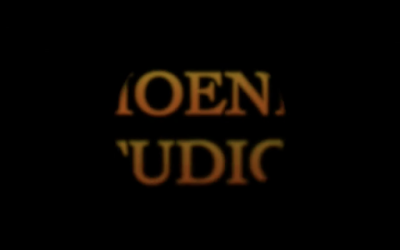
ELEMENTA PRODUCTIONS
Elementa productions was a harder ident to creatively think of, however we settled on this design:
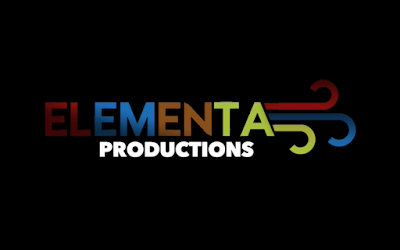
We used the transparent logo of Elementa Productions to add the professional look to the ident, however we added productions to the bottom to allow an animation to take place.

What is this animation I hear you ask? Well, we used a wipe transition to push the logo into the center of the screen from the right.

And then 'Productions' pushing from the left.

And that's our two idents created!
Next time: Time to exhibit the Rough Cut! See you then!
Tuesday, 1 March 2016
Editing
Welcome back! Today, I will be showing you our film during the editing phase!
Now that we have filmed, it's time to plug the camera into the Mac and import all of our footage into Final Cut Pro, the editing software we utilise.
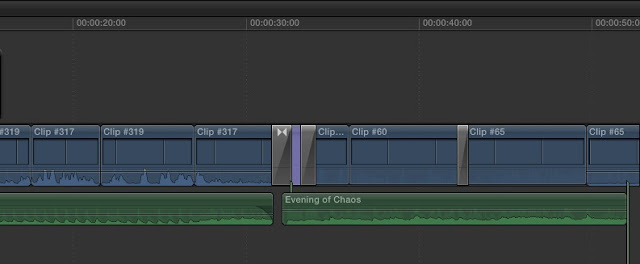
The first stage was to edit the kitchen scene, in which contained a shot/reverse shot. We simply reviewed the clips in the libary and used CTRL+I and CTRL+O to mark where we want the clip to start and end, we then proceeded to add this to the timeline. We did this for each shot until the end of the kitchen scene. Then, we needed a light but erie soundtrack, in which can be found here.
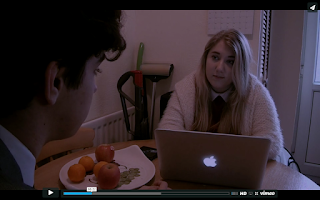
To allow our film opening the dark and erie feel, we had to set the film during night time, however, the camera we recorded with does not like dark places, because of grain. Therefore, we filmed the kitchen scene and establishing shot in broad daylight and used the 'Day Into Night' filter on the clips to give a blue/black tint towards the clip. As you can see, it does give a 'night time' feel to the clip!
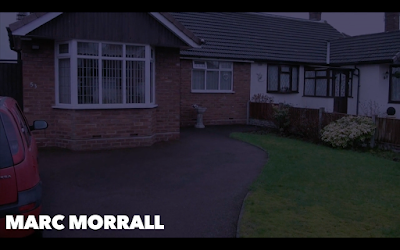

To allow a fludity between the kitchen scene and the bedroom scene, we faded to black for around 1 second. Within this fade, we added our next soundtrack in which can be found here. This acted as a sound bridge for our bedroom scene.
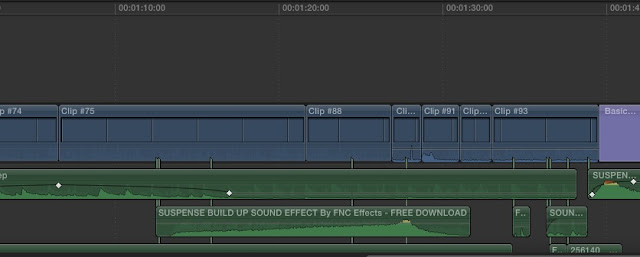
This next part to the editing was vitally important to the film, as creating tension through the soundtrack and the accuracy of editing was a big part of how we wanted to build tension. We used crescendo sound in which allowed us to slowly reveal the other bedroom.
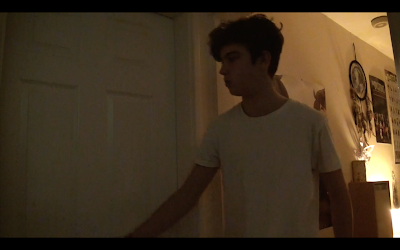
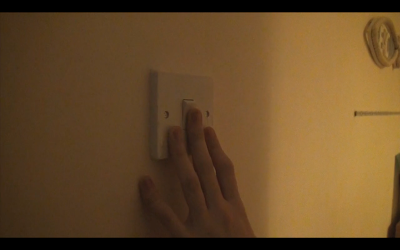
The accuracy of editing really helped in terms of our match-on-actions for the light and door for the build up of tension as it elongated the time for Ian (Marc) to enter the room, in which, with the build up of the sound effect and the original soundtrack, built the tension fantastically. The reveal of Jane (Sara) in the bed turning over relieved tension towards the audience until Bonnie (also Sara) walks into the room. We used a 'piano hit' sound in which was around +12Db in which made the sound incredibly loud to jump the audience. This proceeded with a straight cut to black for the next scene.
Next time: Ident Constuctions! See you then!
Friday, 19 February 2016
Shooting on Location Diary - Day 2
Welcome back! Today, I will present to you the second 'vlog' of our shooting on location diary!
DAY 2 - THE MAIN SECTION OF THE FILM OPENING
Day 2 was another 3 hour slot in which we filmed the rest of the film. We filmed the rest of the film in order from the kitchen scene onwards due to costume changes being minimal.
So let's look at the schedule for day 2:
With the schedule noted let's look at the 'vlog' for Day 2 to give you an insight into how we actually managed to film the rest of the film opening in 3 hours:
WAS IT A SUCCESSFUL DAY?
WAS IT A SUCCESSFUL DAY?
Overall, It was a successful day, we managed to film all of the planned shots with no continuity errors. However, It was a little dark at times, however we can improve that in the final cut. Overall, I thought that the day was handled very professionally considering the few hiccups in the acting etc which are visible in the 'vlog'.
WHAT WAS MY CONTRIBUTION TO THE TWO DAYS OF FILMING?
My contribution to the 2 days of shooting we as follows, make sure that everything is recorded and recorded to the appropriate standard! My role within the film doesn't really kick in till the editing stage. But overall, I thought I did my job very well, I simply worked with Tam, the director, and discussed shots and how we could maybe manipulate and change certain scenes to look aesthetically more pleasing to the audience.
Next time: Editing! Let's see if my skills are any good...
Monday, 8 February 2016
Shooting on Location Diary - Day 1
Welcome back! We've not talked in a very long time, and that is because we have been filming, editing and presenting our rough cut, Somnium! In this post, I will presenting to you the first of two 'vlogs' in which we filmed alongside the filming of our product. These 'vlogs' are exclusive footage from behind the scenes!
DAY 1 - ESTABLISHING SHOT AND KITCHEN SCENE
Day 1 consisted of a 3 hour time slot to film the POV with Ian walking into the house and into the kitchen to greet Jane, with a few pieces of dialogue to finish the day off. But, just to make it formal here is how the day was scheduled:
So, here is our first of 2 'vlogs':
WAS THE DAY SUCCESSFUL?
The day was relatively successful, we started with Marc (Ian) handling the camera because it was a POV in which, the camera would start by pointing towards the house then tilting down into Marc's feet while he walks towards the house.
However, when we came to film the shot / reverse shot, Tam's cat had a fit in which prevented us from filming at our desired location any further. Because of this we had to change location very, very quickly as time was running out. Luckily one of our actors, Sara, allowed us to use her home as our new location.
Due to all of this, we had to record the POV and dialogue at Sara's home before the time ran out which was hectic to say the least.
Next time: Shooting on Location Day 2!
Thursday, 21 January 2016
Shooting Schedule
Welcome back! Today, I will present the shooting schedule for our film 'Somnium'!
WHATS A SHOOTING SCHEDULE?
A shooting schedule is a project plan for each day's shooting for a film. They are usually created by the assistant director and then reported to the production manager then from production manager to the production crew.
WHATS A SHOOTING SCHEDULE?
A shooting schedule is a project plan for each day's shooting for a film. They are usually created by the assistant director and then reported to the production manager then from production manager to the production crew.
Next time: Shooting on location! See you on the set!
Wednesday, 20 January 2016
Actor Release Forms
Welcome back! Today, I will present our actor release forms!
WHAT ARE ACTOR RELEASE FORMS?
Actor release forms are the legal documents that have to be signed in order for the actor to be able to a part of the film. Therefore, if an actor release form is not signed, it's only a matter of time before you have to remove the best shot in the film just because a parent doesn't want their child's face on the internet.
WHAT ARE ACTOR RELEASE FORMS?
Actor release forms are the legal documents that have to be signed in order for the actor to be able to a part of the film. Therefore, if an actor release form is not signed, it's only a matter of time before you have to remove the best shot in the film just because a parent doesn't want their child's face on the internet.
Next time: Shooting Schedule!
Tuesday, 19 January 2016
Risk Assessment
Welcome back! Today, I will present our risk assessment table as well as a little explanation into what they are and why they are used.
WHAT ARE RISK ASSESSMENTS?
Risk assessments are a process in which the activity (in our case, it is shooting on location), is evaluated for potential risks that might occur during the activity.
WHY DO WE NEED A RISK ASSESSMENT?
We need a risk assessment to secure safety for all crew members and actors when shooting on location in which they will be clearly informed of what the risks are. Basically, health and safety is very important in the 21st century, therefore building a risk assessment allows clear checks to be placed onto the location which will enable to avoid those risks and ultimately pass the location off as a 'safe' location.
'SOMNIUM' RISK ASSESSMENT
Next time: Actor Release Forms!
Friday, 15 January 2016
Animatic
Welcome back! Today, I will exhibit our Animatic!
Next time: Risk Assessments! See you then!
Sunday, 10 January 2016
Animatic Research
Welcome back! Today, I will conduct some animatic research including an example from an existing product! So sit back, this could be a long one...
First of all, let's get the research part out of the way shall we...
Now, let's have a look at an animatic from an existing film.
As you can see with this animatic, it has probably been re-made many times to make it perfect, as it is pretty much the exact same of the final product!
Next time: I will exhibit our animatic! See you then!
Saturday, 9 January 2016
Storyboard Research
Welcome back! Today, I will present some storyboard research! After that, I will present our storyboard for our main product!
WHAT IS A STORYBOARD?
As its definition, a storyboard is a sequence of drawings, typically with some directions and dialogue, representing the shots planned for a film. In which are laid like this:

Within this, you can see that titles are also designed within the storyboard in which also contains the transitions to which it will utilise. Furthermore, time frames are also noted for each of these scenes.
EXAMPLE OF A STORYBOARD
So, let's look at Harry Potter and the Deathly Hallows Part 2, in particular the scene in which Nagini, Voldemorts snake, attacks Harry.

As you can see, the storyboard contains a description of the shot and a transition between each box.
WHAT IS A STORYBOARD?
As its definition, a storyboard is a sequence of drawings, typically with some directions and dialogue, representing the shots planned for a film. In which are laid like this:
Within this, you can see that titles are also designed within the storyboard in which also contains the transitions to which it will utilise. Furthermore, time frames are also noted for each of these scenes.
EXAMPLE OF A STORYBOARD
So, let's look at Harry Potter and the Deathly Hallows Part 2, in particular the scene in which Nagini, Voldemorts snake, attacks Harry.
As you can see, the storyboard contains a description of the shot and a transition between each box.
Now let's compare it to the actual scene! Starts around (2:25)
The actual scene contains Harry standing up with a chair in his hands as Nagini is revealed. Nagini does strike the chair as shown in box 'B' as well as a direct cut back to Nagini when she strikes again and forces Harry into another room. To conclude, the storyboard does not match the actual scene completely.
OUR STORYBOARD FOR 'SOMNIUM'
Next time: I will conduct animatic research! See you then!
Subscribe to:
Comments (Atom)

